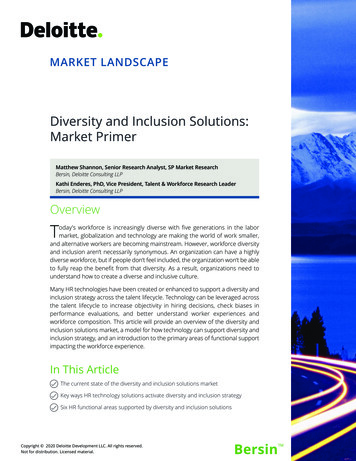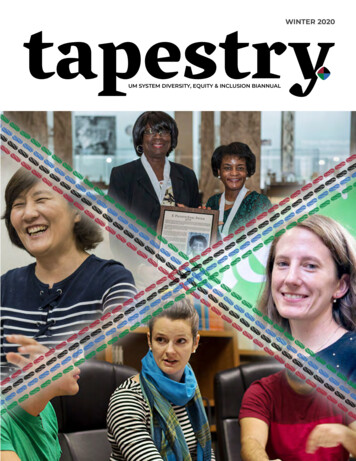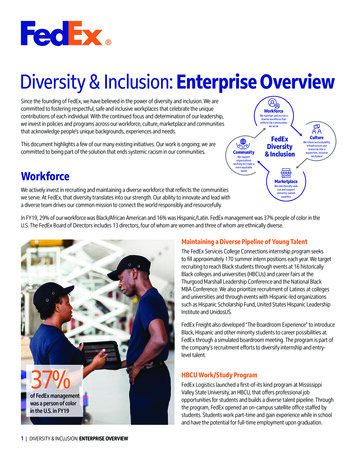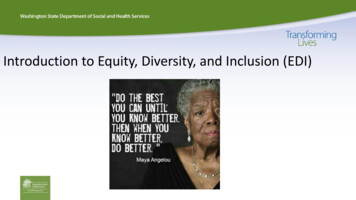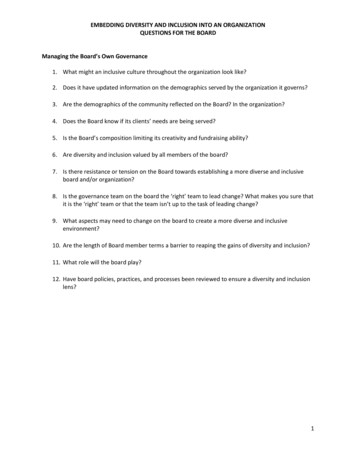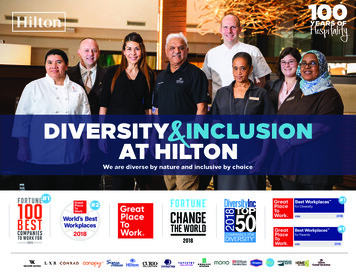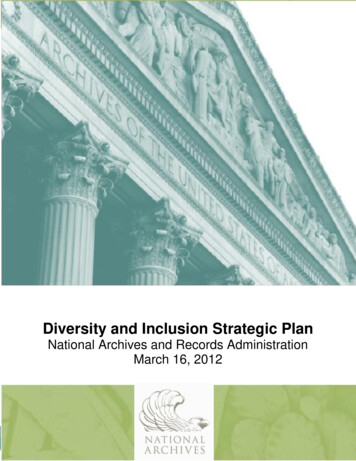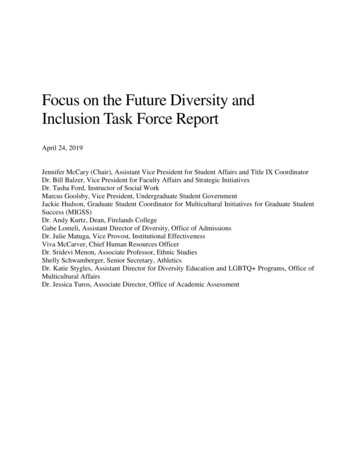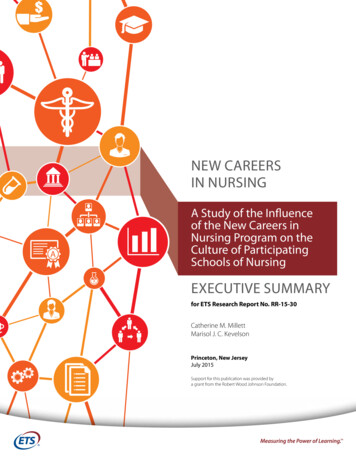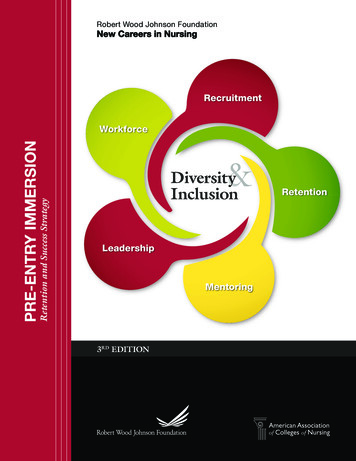
Transcription
Robert Wood Johnson FoundationNew Careers in NursingRecruitmentRetention and Success StrategyPRE-ENTRY toring3RD EDITIONRetention
Pre-Entry Immersion Program ToolkitThird EditionAugust 2016CREATED IN COLLABORATION WITH:Becky Choi, Principalgroupforward, LLCWashington, DCVernell DeWitty, PhD, MBA, MSN, RN, Program DirectorNew Careers in Nursing Scholarship Program, American Association of Colleges of Nursing, Washington, D.C.EDITED BY:Ann Marie P. Mauro, PhD, RN, CNL, CNE, Assistant Dean, Professor, & DirectorCenter for Educational Research & Innovation, School of Nursing, Rutgers, The State University of New JerseySpecial acknowledgement to Management Sciences Health for permission to use and adapt the exerciseformat from Managers Who Lead: A Handbook for Improving Health Services, Cambridge, MA, ManagementSciences for Health 2005. COPYRIGHT 2016 New Careers in NursingWashington, D.C., 2016. Published by agreement between the Robert Wood Johnson Foundation and theAmerican Association of Colleges of Nursing for the Robert Wood Johnson Foundation New Careers inNursing Scholarship Program (NCIN). Correspondence: NCIN — One Dupont Circle, NW, Suite 530,Washington, D.C. 20036-1120. www.newcareersinnursing.orgThis toolkit may be used, downloaded, reproduced, publicly displayed or reprinted forpersonal/noncommercial purposes only.Permission to reproduce for commercial application must be obtained from NCIN in writing.
Robert Wood Johnson Foundation New Careers in NursingPIP ToolkitPage 2Task Force on the Development of New Careers in NursingPre-Entry Immersion ProgramBarbara Lee, MSN, RNAssociate Professor & BSN ChairDepartment of NursingLansing School of Nursing and Health SciencesBellarmine UniversityJoan Masters, EdD, RNProfessorDepartment of NursingLansing School of Nursing and Health SciencesBellarmine UniversityBennie Marshall, EdD, RNRetired Professor & Department HeadDepartment of Nursing and Allied HealthNorfolk State UniversityPatricia Cowan, PhD, RNDean and ProfessorCollege of NursingUniversity of Arkansas for Medical SciencesCecil Holland, EdD, PhD, RNAssociate Professor & Assistant DeanAdmissions, Student Affairs & ProgramEffectivenessDivision of Nursing, School of Health SciencesWinston-Salem State UniversitySarah Shealy, MSN, CNM, RNAssistant ProfessorDirector of Accelerated BSN ProgramDepartment of NursingMount St. Mary’s UniversityElizabeth Speakman EdD, RN, ANEFAssociate Professor & Co-DirectorJefferson Interprofessional Education CenterCollege of NursingThomas Jefferson UniversityGail Schoen Lemaire, PhD, RNAssociate Professor & Associate DeanMaster of Science ProgramSchool of NursingUniversity of Maryland, BaltimoreVernell DeWitty, PhD, RNProgram Deputy DirectorRWJF New Careers in NursingAmerican Association of Colleges of NursingWashington, D.C.Jihanne Jeanty, BAProgram AssistantNew Careers in NursingAmerican Association of Colleges of NursingWashington, D.C.
Robert Wood Johnson Foundation New Careers in NursingPIP ToolkitPage 3THE PRE-ENTRY IMMERSION PROGRAM (PIP) TOOLKIT CONTENTSPreface5Objectives6How to Use the Toolkit7Designing a PIP Plan7Orientation and Support Assessment8PIP Design Process10Basic PIP Plan11PIP Two Day Seminar Format – Sample12Part I:Nursing School Introduction14Section One: IntroductionSection Two: Presentations and ExercisesA. Introduction to Nursing PresentationB. Who Are You ExerciseC. Nursing Experience Exercise1414141721Part II: The Accelerated Learning ProcessSection One: IntroductionSection Two: Presentation and ExercisesA. The Accelerated Learning Process – What to ExpectB. Campus TourPart III: Time ManagementSection One: IntroductionSection Two: Presentations and ExercisesA. Time Management PresentationB. Time Tracking for Time Management ExercisePart IV: Skill DevelopmentSection One: IntroductionSection Two: Presentations and ExercisesA. Learning and Study Strategies Inventory (LASSI) 39
Robert Wood Johnson Foundation New Careers in NursingPIP ToolkitPage 4B. Study Skills Presentation and ExerciseC. Test Taking Techniques Presentation and ExerciseD. Math Skills for Nursing PresentationPart V: Strategies for Academic SuccessSection One: IntroductionSection Two: PresentationsA. Fitting It All In PresentationB. You Don’t Have Read Every Word Presentation and ExerciseC. Writing with Research: Avoiding Plagiarism and FindingYour Own Voice Presentation and ExercisesD. Getting It While It’s Hot: How to Study and Review for PuttingMaterial in Long-Term Memory PresentationPart VI: Professional SocializationSection One: IntroductionSeciton Two: Presentations and ExercisesA. Nursing Lingo Bingo ExerciseB. Professional Etiquette ExerciseC. Mentoring PresentationPart VII: The Journey from Nursing Student to Nursing LeaderSection One: IntroductionSection Two: Presentations and ActivitiesA. School Policies and Procedures PresentationB. Introduction to FacultyC. Networking Opportunities1. Networking Events2. Professional AssocationsAppendixPIP Agenda TemplateSample PIP Agenda – University of MississippiPIP TOOLKIT 909091949597
Robert Wood Johnson Foundation New Careers in NursingPIP ToolkitPage 5PREFACEThis toolkit, “The NCIN Pre-Entry Immersion Program”, was originally designed for schools of nursingwho were recipients of the Robert Wood Johnson New Careers in Nursing Scholarship grant. Theintent was to guide faculty in preparing scholarship recipients for the rigors of an acceleratednursing program. The need for such a guidebook resulted from survey responses from NCIN scholarswho reported “what they wish they had known” at the beginning of their journey into the nursingprofession. An advisory group of faculty members was selected to collaborate on developing subjectmatter for the toolkit. The goal was to ensure learning and success among scholars overall – withparticular emphasis on students from underrepresented groups in nursing.The selected design and implementation recommendations are consistent with the structure of HighImpact Practices (http://www.fullerton.edu/hips/index.php) that are transformational learningopportunities inside and outside of the classroom that provide: Performance expectations at appropriately high levelsSignificant student engagement by investment of time and effortMeaningful and substantive learning interactions with faculty, staff, students, or externalentitiesExperiences with diversity, complexity, and changeFrequent and meaningful feedbackReflection and integrationSchools of nursing reported extremely positive outcomes of this program and made decisions toextend the program to all incoming students, not only NCIN scholars. Students’ survey responsesregarding the impact of the PIP program were consistent with outcomes reported by faculty.During its’ eight years of operation, the NCIN program awarded 3,506 scholarships to students fromgroups underrepresented in nursing in 130 schools of nursing in 41 states and the District ofColumbia. The overall rate of attrition was 7% (246) over the eight years. We attribute some of thissuccess to the implementation of the PIP program that occurred during the third year. We invite youto review and customize this toolkit to the learning needs of your institutions and your students.This is one strategy that will support learning and graduating of all populations of students at similarrates.
Robert Wood Johnson Foundation New Careers in NursingPIP ToolkitPage 6PIP TOOLKIT OBJECTIVESThe objectives of the PIP Toolkit are to: Address the self-identified needs of nursing students as they begin accelerated or other entrylevel programs of study. Provide information and guidance on implementing pre-entry support for students prior to theirentry into an accelerated or other entry-level nursing program. Provide turnkey instructional options for mentoring and leadership development activities fornursing schools. Provide support and structured opportunities to increase students’ success as they enter thenursing program and ensure retention as they move into the nursing profession. Provide information on how to encourage grantees and other nursing schools to explore anddevelop partnerships using innovative strategies to increase diversity in nursing leadership.
Robert Wood Johnson Foundation New Careers in NursingPIP ToolkitPage 7HOW TO USE THE PIP TOOLKITThis Toolkit begins with an Orientation and Support Assessment that allows you to get a quickoverview of where your school stands currently with respect to the orientation and support that isprovided to students as they enter your nursing program.The Toolkit includes a Basic Plan, which contains all the foundational steps that are integral to thestudents’ continued success as they move into and through your program. Your PIP Plan shouldinclude, at a minimum, the following components: Learning and Study Strategies (LASSI), timemanagement skills, study skills, test taking techniques, mentoring, and leadership development.You are encouraged to use the Basic PIP Plan as a starting point, customizing as necessary to addadditional material for issues unique to your school.DESIGNING A PIP PLANNow, on to developing a PIP plan! Start with the Orientation and Support Assessment and build onwhat you know about your school.Once you have completed the Orientation and Support Assessment, you will have a sense of thelevel of orientation and support you provide and the available resources that will shape the PIP planthat you can provide for the students.Your responses on the Orientation and Support Assessment will indicate how you might use theBasic PIP plan included in this toolkit.Use the Basic PIP plan to verify what you need to offer or use it as a starting point if you have no PIP.The Basic PIP can supplement an already existing plan that might have some gaps, or to fine tune anexisting plan that is missing only a few of the required components.View a sample PIP Agenda in the Appendix, pages 95-97.
Robert Wood Johnson Foundation New Careers in NursingPIP ToolkitPage 8ORIENTATION & SUPPORT ASSESSMENTThis assessment is intended to provide you with an opportunity to gain a quick understanding yourschool’s level of orientation and support provided to students. Each school is a mix of the elementsexamined in the assessment. The assessment will give you a sense of where your organizationstands at this point in time and how you might use the Basic PIP plan included in this tool kit. Youwill be able to identify areas where you may need to shift the orientation and support you provideby determining how you want to convert your “no” response to a “yes.”Because an organization’s level of orientation and support can shift based on changes made to yourschool’s administration and faculty as well as the students in each program, annual assessments ofthe organization are helpful in reviewing the PIP plan and determining if the scope continues to beappropriate or may need to be adjusted.A. Orientation Activities: Information provided to students prior to their entryinto accelerated and other entry-level nursing programs greatly supports theiroverall ability to succeed in the programs and allows for higher retention rates.1. Do you provide PAPER-BASED comprehensive orientation information about theprogram the student is about to enter (booklets, guides, and/or checklists)?2. Do you provide ONLINE comprehensive orientation information about the programthe student is about to enter (booklets, guides, and/or checklists)?3. Do you provide specific information about adult learning and accelerated programs?4. Do you provide specific information about the critical thinking as applied to nursing?5. Do you conduct any in-person orientation meetings?6. Do you conduct any in-person meetings between the students and faculty?7. Do you specifically provide or discuss with the students the time requirements of theprogram and the need for time management and life balance?8. Do you conduct any in-person social activities or gatherings?9. Do you provide the students with the LASSI assessment?10. Do you provide the students with information on study skills or test taking skills?11. Do you provide the students with information on writing skills?12. Do you provide the students with information on nursing and/or basic medicalterminology?13. Do you provide the students with their schedules one to two months in advance ofthe start of the program?14. Do you conduct meetings or provide information on the policies and proceduresspecific to your nursing program?15. Do you provide the students with information about professional etiquette?YesNo
Robert Wood Johnson Foundation New Careers in NursingPIP ToolkitPage 9ORIENTATION AND SUPPORT ASSESSMENT (CONTINUED)B. Support: Ongoing support is critical to a positive learning experience and critical tothe students’ success in the transition from nursing student to nursing leader.YesNo1. Do you conduct periodic check-ins to see how the student is doing and to offersupport services?2. Do you conduct any meetings that allow the students to ask questions of and interactwith nursing professionals (including nurses in specialty fields) to introduce them to thehealth care industry in general and the nursing profession specifically?3. Do you provide ongoing professional socialization opportunities where the studentscan learn the language of nursing, meet nursing professionals, and/or see nursingprofessionals in practice?4. Do students have access to a student counseling center?5. Do students have access to academic support services?6. Do students have access to a financial aid office?7. Do you have a mentor program that matches students with mentors or alumnimentors from the nursing profession and/or nursing specialties?8. Do you have an alumni association that is active with the students?9. Do you have a leadership development program?C. Post Program Support: Once a student graduates from the acceleratedprogram, continued support often makes the difference for retention in the field.YesNo1. Do you have an active alumni association or network that interacts professionallyand/or socially with your graduates?2. Do you offer any graduate-alumni mentoring programs?Once you have completed your assessment, and reviewed your answers, review the recommendedPIP plan and begin making modifications to your orientation as needed. Plan a program that willoffer all the required components.Source: Format and text adapted from Organizational Self-Assessment by Antonia Villarruel, PhD, RN, FAAN.
Page 10Robert Wood Johnson Foundation New Careers in NursingPIP ToolkitPIP PLANDESIGN PROCESSORIENTATION AND SUPPORT ASSESSMENTAssess the level of orientation and support your school providesto determine the scope of your PIP plan.PIP PLAN DESIGNThe results of your assessment will guide you as to how to modify yourorientation activities. Review the recommended PIP plan and begin to makemodifications to your orientation program as needed or start with the Basic PIP Plan.Plan a program that will offer all the required components.Learning and StudyStrategies (LASSI)StudySkillsTime ManagementSkillsRequiredComponentsTest TakingTechniquesMentoringLeadershipDevelopment
Robert Wood Johnson Foundation New Careers in NursingPIP ToolkitPage 11BASIC PIP PLANBased on your Orientation and Support Assessment results, you can determine if you need to beginwith the Basic PIP Plan, supplement your existing plan with more components, or fine tune yourexisting PIP plan to provide all the required components.BASIC PIP PLANNursing School Introduction1. Introduction to Nursing Presentation1. Who Are You Exercise2. Nursing Experience ExercisePage 14Page 14Page 17Page 21The Accelerated Learning Process1. The Accelerated Learning Process – What to Expect2. Campus TourPage 24Page 24Page 30Time Management1. Time Management Presentation2. Time Tracking for Time Management ExercisePage 31Page 31Page 35Skill Development1. LASSI Introductory Presentation (LASSI to be taken prior to PIP)2. Study Skills Presentation and Exercise3. Test Taking Techniques Presentation and Exercise4. Math Skills in Nursing PresentationPage 39Page 39Page 42Page 47Page 50Strategies for Academic Success1. Fitting It All In Presentation2. You Don’t Have Read Every Word Presentation and Exercise3. Writing with Research: Avoiding Plagiarism and Finding Your Own VoicePresentation and Exercises4. Getting It While It’s Hot: How to Study and Review for Putting Material in LongTerm Memory PresentationPage 57Page 57Page 61Professional Socialization1. Nursing Lingo Bingo Exercise2. Professional Etiquette Exercise3. Mentoring PresentationPage 75Page 75Page 79Page 85The Journey from Nursing Student to Nursing Leader1. School Policies and Procedures Presentation2. Introduction to Faculty3. Networking Opportunities4. Professional AssociationsPage 89Page 89Page 90Page 90Page 91Page 66Page 72
Page 12Robert Wood Johnson Foundation New Careers in NursingPIP ToolkitTHE PIP 2-DAY SEMINAR FORMATSCHOOL OF NURSINGPRE-ENTRY IMMERSION PROGRAMRECOMMENDED READING PRE-ASSIGNMENT: NUGENT, P. M., & VITALE, B. A. (2015). TEST SUCCESS: TEST-TAKING TECHNIQUES FORTHBEGINNING NURSING STUDENTS (7 ED.). PHILADELPHIA, PA: F.A. DAVIS.APPROXIMATE TIME5 minutes10 minutes75 minutes(1.25 hours)120 minutes(2 hours)45 minutes30 minutes15 minutesDAY ONE: ACTIVITYLEADWelcome – Introduction to PIPReview of Agenda/Logistics – cell phonesoff, location of restroomsStudent Introductions/FacultyIntroductions – each person gives theirname, faculty members identify what theyteach.Nursing School Introduction – brief set upfor presentation and exercisesIntroduction to Nursing PresentationWho Are You ExerciseDean, Program LeadProgram LeadNursing Experience ExerciseThe Accelerated Learning Process – Whatto Expect – participants meet with currentstudents to learn how to deal with therigors of an accelerated program.Campus Tour (and Lunch) – Participantsget physically acclimated to the campus.Skill Development:Time Management Presentation– brief setup for exercise on day two – hand out timeTracking Journal for students to track theirevening activities. Have students readChapter 3 of Test Success.Study Skills Presentation – brief set up forexercise on day two – hand out textbookchapter for students to read before daytwo. Have students read Chapter 4 of TestSuccess.School Resources – introduce schoolsupport staff and resources available forstudent support.Close Day One – students each give theirbig “take away” for the day.RESOURCESProgram LeadProgram LeadProgram LeadProgram Lead orFaculty MemberProgram Lead orFaculty MemberProgram Lead orFaculty MemberPage 14Page 14Page 17Page 21Page 24Program LeadPage 30Program Lead orFaculty MemberPage 31Program Lead orFaculty MemberPage 42Program LeadProgram Lead
Page 13Robert Wood Johnson Foundation New Careers in NursingPIP ToolkitAPPROXIMATE TIMEDAY TWO: ACTIVITYLEADRESOURCESProgram LeadPage 36120 minutes(2 hours)Skill Development:Time Management Skills Exercise – usingTime Tracking Journals students made forprior eveningLASSI Introductory PresentationStudy Skills Exercise – using textbookchapter students read in preparation forday two.Program LeadProgram LeadPage 39Page 45Test Taking Techniques PresentationMath Skills in Nursing PresentationFitting It All In PresentationYou Don’t Have Read Every WordPresentation and ExerciseWriting with Research: AvoidingPlagiarism and Finding Your Own VoicePresentation and ExercisesGetting It While It’s Hot: How to Study andReview for Putting Material in Long-TermMemory PresentationProfessional Socialization – brief set up forpresentations and exercisesNursing Lingo Bingo ExerciseProfessional Etiquette ExerciseMentoring PresentationThe Journey from Nursing Student toNursing Leader – brief set up forpresentationsSchool Polici
Lansing School of Nursing and Health Sciences Bellarmine University Joan Masters, EdD, RN Professor Department of Nursing Lansing School of Nursing and Health Sciences . intent was to guide faculty in preparing scholarship recipients for the rigors of an accelerated nursing program. The need for such a guidebook resulted from survey responses .
